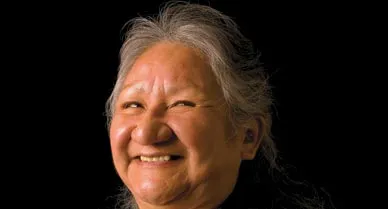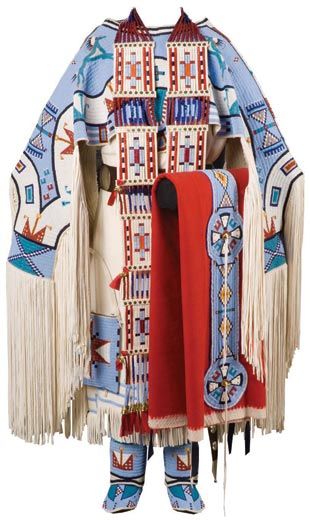Beading the Way
How Joyce Growing Thunder Fogarty created one of the centerpieces for the National Museum of American Indian’s “Identity by Design” exhibition
/https://tf-cmsv2-smithsonianmag-media.s3.amazonaws.com/filer/mall-indianbead-main-631.jpg)
Made from elk skin and covered in countless blue and white beads sewed on one at a time, the dress is a highlight of the National Museum of the American Indian's "Identity by Design" exhibition, recently extended to August 2008. Perhaps the dress's most striking detail is the recurring image of a horse wearing a feathered war bonnet, and therein lies the story of Joyce Growing Thunder Fogarty and her ancestors.
The Assiniboine/Sioux Indian is one of the West's most highly regarded beadworkers. She has created more than 500 dresses, cradle boards, dolls and other pieces, and has won top honors at the Southwestern Association for Indian Arts' annual show in Santa Fe three times—more than any other artist.
So Growing Thunder Fogarty, 57, was a natural for the "Identity by Design" exhibit, which showcases 55 Native American dresses and 200 accessories from the 1830s to the present. "We wanted to feature a contemporary woman who was keeping tradition alive today," says co-curator Emil Her Many Horses.
Thrilled by the museum's request, Growing Thunder Fogarty instantly had an idea for the design.
She had grown up on the Fort Peck Indian Reservation in Montana, where her grandfather Ben Gray Hawk, a tribal leader, performed a traditional "giveaway" ceremony. He would tie a war bonnet to a horse's head, sing a song paying tribute to loved ones and turn the horse loose into a crowd of men. Whoever caught the horse was able to keep it, an act of generosity meant to honor Gray Hawk's grandchildren.
Thus Growing Thunder Fogarty's "Give Away Horses" dress, which she worked on every day for ten months, usually waking at 4 a.m. and beading at her kitchen table for 16 hours. She says she felt the spirit of her ancestors beading along with her. Her daughter, Juanita Growing Thunder Fogarty, and 18-year-old granddaughter, Jessica, who live in North San Juan, California, pitched in. Juanita made the breastplate, belt, knife case, awl case and bag for fire-starting tools; and Jessica made a beaded strip for the blanket. "We were constantly working," Juanita recalls. "Every now and then, I'd throw in a load of laundry, but we just kept at it."
The dress is Sioux-style, meaning the yoke (or cape) is completely covered in the small glass "seed" beads that Europeans introduced to Native artisans around 1840. (Originally, they made beads from shell, bone and stone.) The dress depicts not only horses and their tracks but also the rectangular drums used at the giveaway ceremony. Some of the accessories, such as the awl case (traditionally used to carry sewing tools), are seldom seen with modern Indian dresses. "I really wanted to make it real," Joyce says.
She had originally intended to give the dress to the museum, but curators arranged for a donor, Elaine Dee Barker, to underwrite some of the work, and therein lies another story about generosity and the past. For the last seven years, Joyce has lived in Socorro, New Mexico, but she used the commission this past September to buy a house on the Fort Peck Reservation where she was brought up. She now lives two doors down from her son and his family and is teaching a younger generation her craft. "She's gone home in a sense," daughter Juanita says. "And she's helping to preserve our traditions and keep our culture alive."

